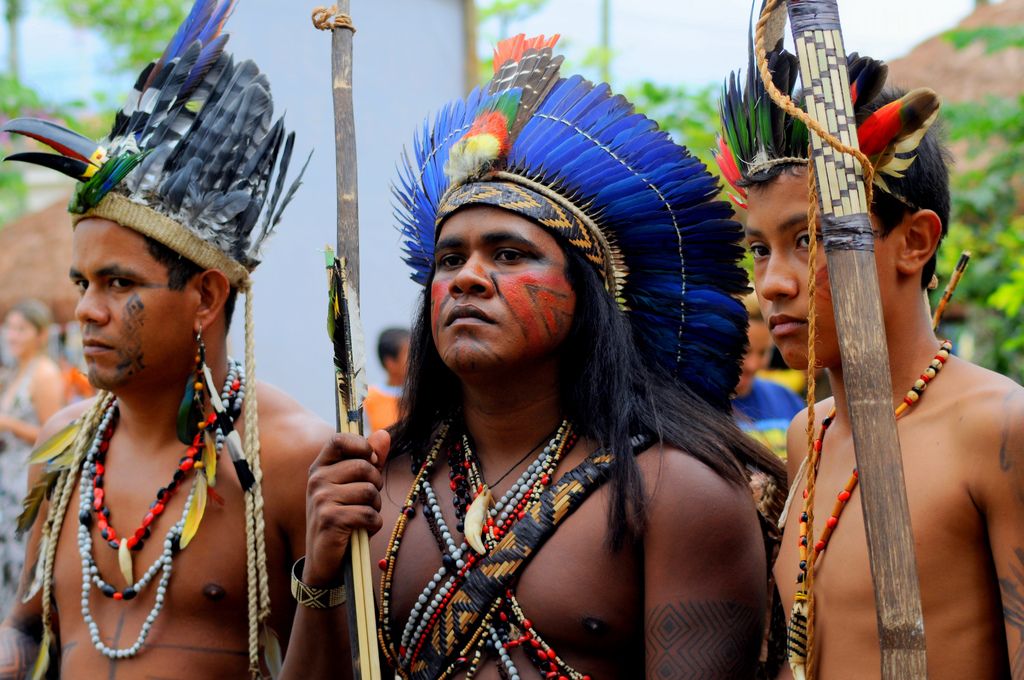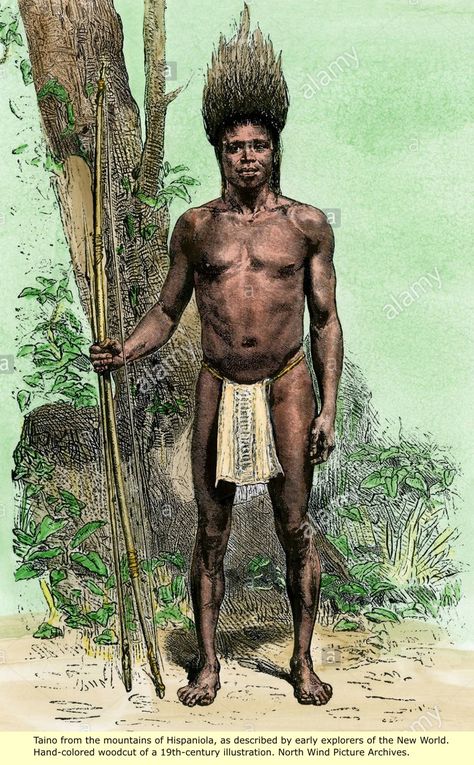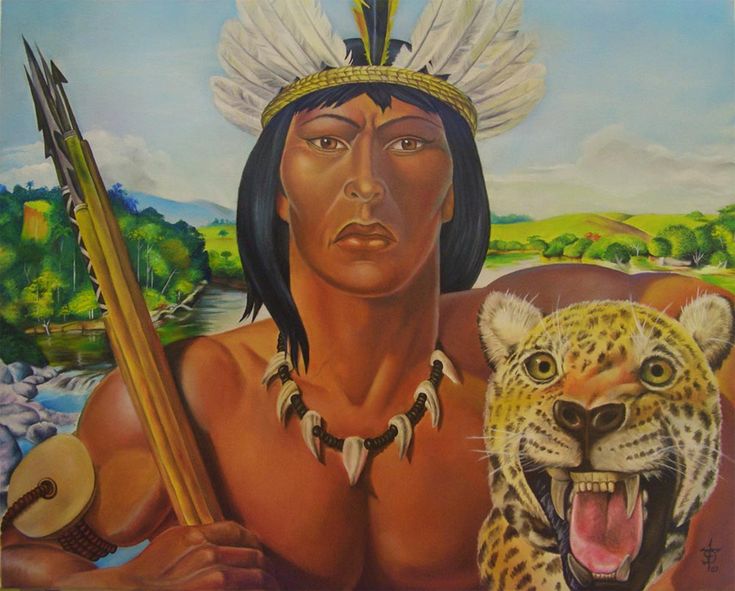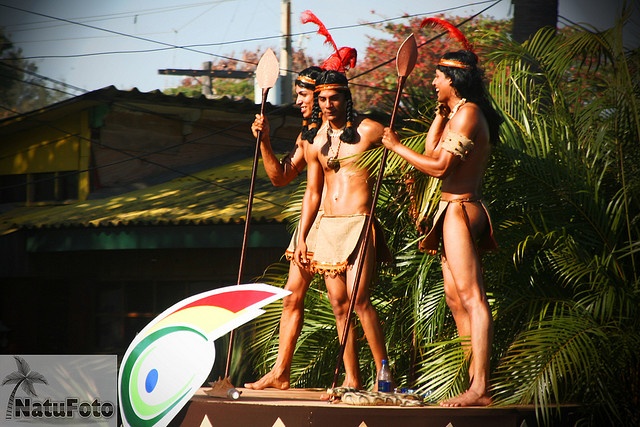Indios tainos: What Became of the Taíno? | Travel
Taíno: Native Heritage and Identity in the Caribbean | Taíno: herencia e identidad indígena en el Caribe
July 28, 2018–November 12, 2019
New York, NY
Across the Caribbean, there is growing interest in the historical, cultural, and genetic legacies of Native peoples. In increasing numbers, individuals, families, and organizations are affirming their Native ancestry and identifying themselves as Taíno.
Over the past thirty years, a diverse Taíno movement has taken form. This movement challenges the prevalent belief that Native peoples became extinct shortly after European colonization in the Greater Antilles. It is spurring a regeneration of Indigenous identity within the racially mixed and culturally blended societies of Cuba, the Dominican Republic, and Puerto Rico, as well as other areas of the Caribbean.
In this exhibition, visitors will explore the rural roots of the Taíno movement and find information about the legacy of Native peoples throughout the Spanish-speaking Caribbean islands and their U. S. diasporas.
S. diasporas.
Taíno: Native Heritage and Identity in the Caribbeanis a collaboration of the National Museum of the American Indian and the Smithsonian Latino Center. This exhibition and related programming are made possible through the support of the Ralph Lauren Corporation and INICIA of the Dominican Republic. Federal support is provided by the Latino Initiatives Pool, administered by the Smithsonian Latino Center.
Por todo el Caribe existe un creciente interés en el legado histórico, cultural y genético de los pueblos indígenas. Hay un número cada vez más grande de personas, familias y organizaciones que afirman su ascendencia indígena y se identifican a sí mismas como taínos.
A lo largo de los últimos 30 años se ha conformado un movimiento taíno diverso. Este movimiento cuestiona la creencia predominante de que los pueblos indígenas quedaron extinguidos poco después de la colonización europea en las Antillas Mayores. Está suscitando una regeneración de la identidad indígena dentro de las sociedades mestizas y culturalmente mezcladas de Cuba, la República Dominicana y Puerto Rico, así como de otras áreas del Caribe.
En esta exposición podrá observar las raíces rurales del movimiento taíno y encontrar información acerca del legado de los pueblos indígenas a través de las islas del Caribe de habla hispana y sus diásporas en los Estados Unidos.
Taíno: herencia e identidad indígena en el Caribe es una colaboración entre el Museo Nacional del Indígena Americano y el Centro Latino Smithsonian. La exposición y su programación han sido patrocinados con la generosidad de la Corporación Ralph Lauren e INICIA de la República Dominicana. Apoyo federal ha sido provisto por el Fondo de Iniciativas Latino, administrado por el Centro Latino Smithsonian.
This type of
cemí, known as a cabeza de Macorix, developed on the island of Hispaniola (present-day Haiti and the Dominican Republic). It is related to three-corner stone cemis in both design and spiritual function. This one probably represents a Native leader who was venerated after death.
Taíno (Chican Ostionoid) cemi carved to represent a human head, AD 800–1500.
 San Pedro de Macorís Province, Dominican Republic. Stone. Purchased in 1941 from A. E. Todd. (20/3511)
San Pedro de Macorís Province, Dominican Republic. Stone. Purchased in 1941 from A. E. Todd. (20/3511)
Este tipo de cemí, conocido como cabeza de Macorix, se desarrolló en la isla de La Española (hoy Haití y la República Dominicana). Se relaciona con el trigonolito tanto en diseño como en función espiritual. Este probablemente representa a un líder indígena quien fue venerado después de morir.
Cemí taíno (chican ostionoide) tallado para representar una cabeza humana, d. C. 800-1500. Provincia de San Pedro de Macorís (República Dominicana). Piedra. Adquirido en 1941 de A. E. Todd. (20/3511)
A Native woman (thought to be Luisa Gainsa) and child near Baracoa, Cuba, 1919. Native communities in eastern Cuba today work with researchers to document their history and culture.
Photo by Mark Raymond Harrington, 1919. National Museum of the American Indian, Smithsonian Institution. (N04469)
Una mujer indígena (se cree que es Luisa Gainsa) y una niña, cerca de Baracoa (Cuba), 1919. Comunidades indígenas en el este de Cuba hoy en día trabajan con investigadores para documentar su historia y cultura.
Comunidades indígenas en el este de Cuba hoy en día trabajan con investigadores para documentar su historia y cultura.
Fotografía por Mark Raymond Harrington, 1919. Museo Nacional del Indígena Americano, Institución Smithsonian. (N04469)
Enslavement, resistance, and spirituality connected the cultures and lives of African and Native peoples across the Caribbean. This print depicts enslaved laborers working a sugar plantation on Hispaniola (present-day Haiti and the Dominican Republic) in the early 1500s.
Illustration from
Naaukeurige versameling der gedenk-waardigste zee en land-reysen na Oost en West-Indiën … zedert het jaar 1492 tot 1499 (Careful collection of the most memorable sea and land trips to the East and West Indies … dates from 1492 to 1499), published by Pieter van der Aa, 1707. Courtesy of the John Carter Brown Library at Brown University.
La esclavización, la resistencia y la espiritualidad vincularon las culturas y las vidas de los pueblos africanos e indígenas a través del Caribe. Este grabado muestra obreros esclavizados trabajando en una plantación de caña de azúcar en La Española (hoy Haití y la República Dominicana) al comienzo del siglo XVI.
Este grabado muestra obreros esclavizados trabajando en una plantación de caña de azúcar en La Española (hoy Haití y la República Dominicana) al comienzo del siglo XVI.
Ilustración de
Naaukeurige versameling der gedenk-waardigste zee en land-reysen na Oost en West-Indiën… zedert het jaar 1492 tot 1499 (Colección cuidadosa de los viajes por mar y tierra más memorables a las Indias Orientales y Occidentales… fechas de 1492 a 1499), publicado por Pieter van der Aa, 1707. Cortesía de la Biblioteca John Carter Brown de la Universidad Brown.
The Barrientos family was formed by a Spanish ex-soldier and an Indigenous woman from Baracoa, Cuba, more than 400 years after Spanish colonization.
Photo by Mark Raymond Harrington, 1919. National Museum of the American Indian, Smithsonian Institution. (N01404)
La familia Barrientos fue formada por un antiguo soldado español y una mujer indígena de Baracoa (Cuba), más de 400 años después de la colonización española.
Fotografía por Mark Raymond Harrington, 1919. Museo Nacional del Indígena Americano, Institución Smithsonian. (N01404)
Idalis Ramírez Rojas and her daughter, Ingrid, participate in a workshop on local medicinal plants with other Native families from eastern Cuba. Native knowledge is embedded in the rural cultures of the Caribbean.
Photo by the Kaweiro Group, 2015.
Idalis Ramírez Rojas y su hija Ingrid participan en un taller sobre plantas medicinales locales con otras familias indígenas del oriente de Cuba. El conocimiento indígena forma parte íntegra de las culturas rurales del Caribe.
Fotografía por el Grupo Kaweiro, 2015.
Puerto Rican superhero La Borinqueña is shown during a mystical encounter with the powerful deity Yucahu, who appears as a mountain-sized version of a
cemi, a type of ritual object. In the comic, she encounters other Native deities originally described in the 1498 chronicle An Account of the Antiquities of the Indians.
Comic book illustration from
La Borinqueña #1, written and created by Edgardo Miranda-Rodriguez. Illustration by Will Rosado and digital colors by Juan Fernández. © 2016 Somos Arte, LLC
La superheroína puertorriqueña La Borinqueña se observa aquí durante un encuentro místico con el poderoso dios Yucahu, que aparece como un cemí (un tipo de objeto ritual) tan grande como una montaña. En el libro de historietas, ella se encuentra con otras deidades indígenas descritas originalmente en la crónica de 1498, Relación acerca de las antigüedades de los indios.
Ilustración del libro de historietas
La Borinqueña # 1, escrito y creado por Edgardo Miranda Rodríguez. Ilustración por Will Rosado y colores digitales por Juan Fernández. © 2016 Somos Arte, LLC
Los Indios Tainos (Original DR Mix) by Ray MD on Beatport
Track
Link:
Embed:
Artists
Ray MD
- Release 99″ data-ec-variant=”album” data-ec-id=”3591575″ data-ec-d1=”Ray MD, Manybeat, CHRIS TEMPO, DJ Lugo, Davis P” data-ec-d2=”Ray MD, Estephany Hernandez”>
- Length
6:28 - Released
2021-12-20 - BPM
120 - Key
E♭ min - Genre
Afro House
- Label
The Warrior Recordings
People Also Bought
- 29″ data-ec-variant=”album” data-ec-id=”3763384″ data-ec-d1=”Natema, Aaron Sevilla, Valentina Facury”> 29″ data-ec-variant=”album” data-ec-id=”3632800″ data-ec-d1=”Riordan”>
Tú Lo Ve
Ferra Black
Nervous Records
No Hablo Español
Riordan
Candy Flip
Recommended Tracks
- 29″ data-ec-variant=”track” data-ec-id=”16688954″ data-ec-d1=”Joy Marquez, Zeuqram” data-ec-d3=”Afro House” data-ec-d4=”Afro / Latin”>
Ninos
Lexah Remix 2022Lexa Hill
29″ data-ec-variant=”track” data-ec-id=”16564879″ data-ec-d1=”Elvis Castellano” data-ec-d3=”Afro House” data-ec-d4=”Afro / Latin”>Afro Journey Beats
Original MixRon Trent
29″ data-ec-variant=”track” data-ec-id=”16150956″ data-ec-d1=”Adrian Daboin” data-ec-d3=”Afro House” data-ec-d4=”Afro / Latin”>Tangible
Original MixMemo Rex
29″ data-ec-variant=”track” data-ec-id=”16034100″ data-ec-d1=”KauraDj, Bongotrack” data-ec-d2=”Afronautas” data-ec-d3=”Afro House”>Masai
Luis Erre Invader RemixBongotrack
29″ data-ec-variant=”track” data-ec-id=”16026670″ data-ec-d1=”Jheans Figueroa” data-ec-d3=”Afro House”>La Sabana De La Costa
Original MixIan Justiniani
29″ data-ec-variant=”track” data-ec-id=”16026649″ data-ec-d1=”Sr. Saco” data-ec-d3=”Afro House”>Nación Shango
Original MixRay MD,
CHRIS TEMPO
29″ data-ec-variant=”track” data-ec-id=”15985548″ data-ec-d1=”Joy Marquez” data-ec-d3=”Afro House” data-ec-d4=”Afro / Latin”>Amandla
Original MixAaron Sevilla,
dbasser
29″ data-ec-variant=”track” data-ec-id=”15770269″ data-ec-d1=”Alexander Zabbi, Mr.Drops” data-ec-d3=”Tech House”>Strings
Original MixDavid Morales
29″ data-ec-variant=”track” data-ec-id=”13791007″ data-ec-d1=”David Tort” data-ec-d2=”Markem, Max Antone” data-ec-d3=”Funky House”>Right On
Original MixSpace Motion
29″ data-ec-variant=”track” data-ec-id=”9765328″ data-ec-d1=”Javier Light, Alberto Dimeo” data-ec-d3=”Tech House”>Walking On Fire
Bedrock Vocal MixEvolution,
Jayn Hanna
Afro Cubano
Original Mix
Joy Marquez,
Zeuqram
Baeidan
Original Mix
Elvis Castellano
Papachongo
Original Mix
Adrian Daboin
Tropa Do BumBum
Afronautas Remix
KauraDj,
Bongotrack
Arabic
Original Mix
Jheans Figueroa
Pirata Africano
Original Mix
Sr. Saco
Palo Santo
Original Mix
Joy Marquez
Tribales
Original Mix
Alexander Zabbi,
Mr.Drops
Hialeah
Markem & Max Antone Remix
David Tort
Groovebeat
Original Mix
Javier Light,
Alberto Dimeo
Thanos Minecraft Fortnite Video game Marvel Comics, Thanos Imperative, television, angle, rectangle png
Thanos Minecraft Fortnite Video game Marvel Comics, Thanos Imperative, television, angle, rectangle png
nine0005 rick,
About this PNG
Image size
- 414x830px
File size
- 101.
 18KB
18KB MIME type
- Image/png
Download PNG ( 101.18KB )
resize PNG
width(px)
height(px)
License
Non-Commercial Use, DMCA Contact Us
Marvel Guardians of the Galaxy Groot, Baby Groot Gamora Rocket Raccoon Thanos, rocket raccoon, comics, fictional Characters, carnivoran png
600x600px
52.79KB
nine0006women’s green sleeveless top and black pants, Pom Klementieff Mantis Guardians of the Galaxy Vol. Gamora Nebula 2, marcos mantis, captain, fictional Character, pom Klementieff Mantis png
445x1125px
557.02KBGamora Marvel: Avengers Alliance Thanos Wanda Maximoff Angela, MARVEL, comics, fictional Character, thanos png
820x1469px
579. 43KB
43KBMarvel Star-Lord painting, Chris Pratt Marvel: Avengers Alliance Star-Lord Guardians of the Galaxy Black Panther, chris pine, celebrities, material, shoe png
2000x3958px
1.58MBMinecraft: Pocket Edition Roblox Sword, others, game, angle, text png
1200x1200px
8.73KBThanos Hulk Action & Toy Figures The Infinity Gauntlet Marvel Comics, Charming Villain, comics, fictional Character, mercenary png
480x884px
497.37KBMinecraft: Pocket Edition Video game Diamond Sword Minecraft: Story Mode, Season Two, 钻石, angle, rectangle, video Game png
512x512px
11.58KB org/ImageObject”>Thanos Hulk Hot Toys Limited 1:6 scale modeling Action & Toy Figures, Hulk, hulk, thanos, 16 Scale Modeling png
600x600px
80.88KBSuper Mario coin illustration, Super Mario Bros. Super Mario World Minecraft, stack of coins, angle, heroes, super Mario Bros png
2000x2100px
116.99KBGroot Rocket Raccoon Dragon Destroyer Gamora Thanos, guardians of the galaxy, superhero, fictional Character, movies png
564x578px
119.82KBMinecraft: Story Mode Minecraft: Pocket Edition Video game Item, rainforest, angle, text, rectangle png
1024x1024px
24.4KBMinecraft Twitch Video game Computer Servers, treasure chest, angle, rectangle, video Game png
1500x1500px
36.2KB
nine0006Diana Prince Logo Female Sticker, woman, miscellaneous, angle, text png
1600x1600px
23.06KBStar-Lord Gamora Drax the Destroyer Thanos Yondu, Thor, beer, film, breaker png
1058x1600px
981.54KB org/ImageObject”>Minecraft Ender Pearl Purple Video game, peral, purple, blue, angle png
538x538px
11.14KBMinecraft Pixel art Bone, bones, miscellaneous, angle, white png
2600x1200px
80.8KB
nine0006Marvel: Avengers Alliance Thanos Wanda Maximoff Carol Danvers Adam Warlock, guardian of the galaxy, marvel Avengers Assemble, superhero, fictional Character png
576x880px
415.94KBMinecraft Creeper Coloring book Video game Paper, Minecraft, game, angle, white png
1188x1188px
8.15KB org/ImageObject”>green tunnel Super Mario art, Mario Pipe, Plumbing s-, angle, text, rectangle png
705x900px
5.63KBquestion mark, New Super Mario Bros. 2 New Super Mario Bros. 2, block, game, angle, text png
1000x1000px
78.63KBMinecraft: Pocket Edition Terraria Minecraft mods, minecraft pixel art unicorn, purple, game, angle png
512x512px
3.68KBBlack Widow Captain America Marvel Comics Symbol, Black Widow, marvel Avengers Assemble, comics, angle png
886x902px
42.44KB org/ImageObject”>Minecraft Coloring book Template Mojang, Minecraft Logo, template, angle, white png
980x980px
8.71KBMinecraft: Pocket Edition Sword Mod Lego Minecraft, texture for galaxy, blue, angle, text png
512x512px
45.55KBMinecraft Pickaxe Video game Item Gold, trendy colorful page, angle, white, text png
1600x1600px
16.7KBDrax the Destroyer Marvel: Avengers Alliance Star-Lord Thanos Lego Marvel Super Heroes, marvel destroyer, superhero, marvel, fictional Character png
1024x1024px
425.97KB org/ImageObject”>Benicio del Toro Collector Avengers: Infinity War Grandmaster Thanos, Thor, textile, meme, thanos png
654x1127px
2.81MBMinecraft: Roblox Chestguard Armour, Minecraft, angle, text, rectangle png
539x539px
12.64KBMinecraft mods Sword Xbox 360, minecraft sword, angle, text, logo png
538x538px
10.5KB
nine0006Minecraft mods Iron Man Spider-Man YouTube, skin, avengers, rectangle, video Game png
640x640px
12.1KBMinecraft: Pocket Edition Xbox 360 Herobrine Roblox, skin, angle, rectangle, video Game png
516x1050px
22. 6KB
6KBMinecraft Skin Theme Computer Software Computer Icons, others, angle, text, rectangle png
376x767px
42.59KBThanos Funko Collector Action & Toy Figures Marvel Cinematic Universe, guardians of the galaxy, fictional Character, thanos, action Figure png
640x640px
519.26KBTetromino Tetris Polemino Decomino, blocks, miscellaneous, angle, text png
1000x667px
5.55KBCrossword Video game Online book Author, indios americanos, angle, text, rectangle png
771x1019px
9.34KBMinecraft Wall decal Sticker Game, mines, game, angle, white png
1600x1600px
1. 34KB
34KBMinecraft: Pocket Edition Mod Item, others, rectangle, orange, diamond png
807x806px
17.47KBMinecraft: Pocket Edition Sword, Minecraft, angle, rectangle, symmetry png
350x450px
71.85KB
nine0006Minecraft Logo Sword Pixel art, others, angle, text, rectangle png
1267x1267px
8.98KBMinecraft The Legend of Zelda Video game Trouble Battery widget, 8-bit heart, game, angle, text png
512x512px
11.28KBRPG Maker MV Tile-based video game Ladder Internet forum, wooden stairs, angle, text, rectangle png
768x576px
297.18KB
Minecraft Paper model Paper model Arcade game, Minecraft Papercraft, template, angle, furniture png
nine08x1283px
13.91KB
nine0087
Clock Minecraft Pixel art Timer Item, Minecraft Heart, rectangle, symmetry, timer png
600x600px
8.41KB
Minecraft: Pocket Edition Deadpool Herobrine Video game, deadpool minecraft skin, game, angle, rectangle png
396x792px
3.25KB
Minecraft: Pocket Edition Carrot Minecraft mods Mojang, carrot slice, game, angle, food png
530x530px
5.67KB
Minecraft Coloring book Video game Skeleton Enderman, minecraft, game, angle, child png
1600x1600px
22.39KB
Minecraft Wall decal Video game Sword, mines, game, angle, white png
1600x1600px
14.21KB
nine0006
Twitch logo, League of Legends Twitch Streaming media, miscellaneous, purple, angle png
500x500px
13.84KB
 18KB
18KB 43KB
43KB 6KB
6KB 34KB
34KB